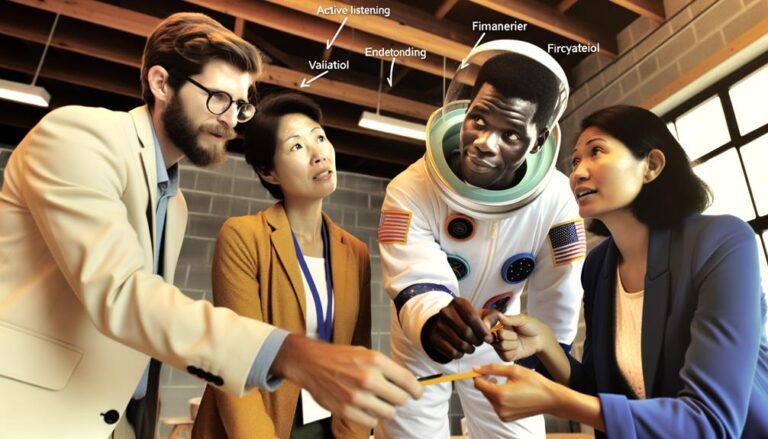The Impact of AI and VR on Training and Development
In today’s rapidly evolving technological landscape, the impact of artificial intelligence (AI) and virtual reality (VR) cannot be underestimated, especially when it comes to training and development.
These innovative technologies have the potential to revolutionize the way we acquire knowledge and skills, offering personalized and adaptive training programs, immersive learning experiences, and enhanced skill development.
But what are the specific implications of AI and VR in the field of training and development? How can they improve employee engagement and performance? And what future trends can we expect?
Join us as we explore the transformative power of AI and VR in the realm of training and development, and uncover the opportunities they present for organizations and individuals alike.
Key Takeaways
- Personalized and adaptive training programs utilizing AI and VR technologies can deliver tailored learning experiences based on individual preferences, performance, and goals in real-time.
- Immersive learning experiences with VR can enhance practical knowledge through realistic simulations, interactive and hands-on learning, and individualized learning paths.
- AI-powered personalized training can enhance skill development by catering to individual needs and preferences, providing immediate feedback and improvements, and identifying skill gaps for targeted training.
- Virtual reality skill simulations offer efficient skill development through immersive and realistic environments, AI-driven skill assessment, advanced and engaging training experiences, and targeted skill development with feedback and progress tracking.
Personalized and Adaptive Training Programs
Personalized and adaptive training programs utilize artificial intelligence (AI) and virtual reality (VR) technologies to deliver tailored learning experiences that cater to the unique needs and abilities of individual learners. These programs leverage AI algorithms and machine learning to analyze a learner’s performance, preferences, and goals in real-time, allowing for the delivery of personalized instruction. By adapting the content, pace, and difficulty level of the training materials, these programs ensure that learners receive targeted instruction that aligns with their individual learning styles and capabilities.
The use of AI and VR in personalized and adaptive training programs has revolutionized the field of education and training. Traditional one-size-fits-all approaches are being replaced with dynamic and interactive learning experiences that can be customized to meet the needs of each learner. Adaptive learning algorithms continuously monitor and assess learner progress, identifying areas of strength and weakness, and providing targeted feedback and support. This approach not only enhances learning outcomes but also promotes self-directed learning and fosters learner engagement.
Furthermore, the integration of VR technology in personalized training programs offers a unique and immersive learning experience. Learners can engage in simulated environments that replicate real-world scenarios, enabling them to practice and apply their skills in a safe and controlled setting. This enhances the transfer of knowledge and skills to real-life situations, making the learning process more effective and practical.
Immersive Learning Experiences With VR
Virtual reality (VR) technology offers a transformative approach to immersive learning experiences. With the ability to create virtual environments that replicate real-world scenarios, VR training provides a personalized learning experience that is highly effective and engaging.
Here are four key aspects of immersive learning experiences with VR:
- Realistic simulations: VR allows learners to experience realistic scenarios that closely resemble their actual work environment. This enables trainees to apply their skills in a simulated setting, enhancing their practical knowledge and preparing them for real-world challenges.
- Interactive and hands-on learning: VR training provides a hands-on approach to learning, allowing trainees to actively engage with the virtual environment. They can manipulate objects, practice tasks, and receive real-time feedback, fostering a deeper understanding of the subject matter.
- Individualized learning paths: VR technology allows for personalized learning experiences by tailoring the content and difficulty level based on the learner’s needs and progress. This adaptive approach ensures that each trainee receives training that is relevant and suitable for their skill level.
- Enhanced retention and transfer of knowledge: Immersive learning experiences with VR have been shown to improve knowledge retention and transfer. By engaging multiple senses and creating a sense of presence, VR training facilitates better memory recall and the application of learned skills in real-world situations.
Enhanced Skill Development Through AI
Enhanced skill development through AI offers several benefits in training and development.
Ai-powered personalized training allows for tailored learning experiences that cater to individual needs and preferences.
Virtual reality skill simulations provide a safe and immersive environment for learners to practice and refine their skills.
Real-time performance analysis allows for immediate feedback and improvements.
Together, these AI-driven techniques contribute to more effective and efficient skill development in various domains.
Ai-Powered Personalized Training
Utilizing artificial intelligence technology, training and development programs can be tailored to individual needs, fostering advanced skill development. This personalized approach to training offers several benefits:
- Personalized coaching: AI algorithms can analyze the learner’s performance and provide real-time feedback, enabling personalized coaching to address specific areas of improvement.
- Adaptive learning: AI systems can adapt the training content based on the learner’s progress and capabilities, ensuring an optimal learning experience that matches their individual pace and learning style.
- Skill gap identification: By analyzing data from multiple sources, AI can identify skill gaps in an individual’s knowledge and provide targeted training to bridge those gaps, allowing for more efficient and effective skill development.
- Continuous improvement: AI-powered training programs can track the learner’s progress over time, providing ongoing feedback and recommendations for further skill enhancement, enabling continuous improvement and growth.
Virtual Reality Skill Simulations
AI-powered virtual reality simulations offer a highly immersive and efficient method for enhancing skill development. These simulations provide a realistic and interactive environment for individuals to practice and improve their skills, allowing for a more engaging and effective learning experience. By incorporating AI-driven skill assessment, virtual reality training effectiveness can be maximized.
To illustrate the impact of virtual reality skill simulations, consider the following table:
| Skill | Traditional Training | Virtual Reality Simulation |
|---|---|---|
| Surgery | Limited hands-on experience | Realistic surgical procedures can be practiced |
| Flight Training | Simulated cockpit experience | Realistic flight scenarios and emergencies can be simulated |
| Sales Techniques | Role-playing exercises | Interactive simulations with virtual customers |
As shown in the table, virtual reality simulations provide a more advanced and immersive training experience compared to traditional methods. With AI-driven skill assessment, individuals can receive personalized feedback and track their progress, leading to more targeted skill development. The combination of virtual reality and AI has the potential to revolutionize training and development by providing a highly effective and efficient platform for enhancing skills.
Real-Time Performance Analysis
Real-time performance analysis plays a crucial role in enhancing skill development through the integration of artificial intelligence. By providing real-time monitoring and AI-driven feedback, this technology enables individuals to receive immediate insights and recommendations to improve their performance.
Here are some key aspects of real-time performance analysis:
- Continuous monitoring: AI algorithms analyze performance data in real-time, allowing for ongoing evaluation and feedback.
- Objective assessment: AI removes subjective biases by providing an unbiased evaluation of performance based on predefined criteria.
- Personalized feedback: AI algorithms can tailor feedback to individual needs, providing customized recommendations for improvement.
- Performance tracking: Real-time analysis enables the tracking of performance trends over time, identifying areas of improvement and growth opportunities.
Realistic Simulations for Safe Practice
Realistic simulations offer a safe and effective means for professionals to practice and refine their skills. Safe practice simulations enable individuals to experience real-world scenarios without the risk of harm, allowing them to learn from their mistakes and improve their performance. These simulations can be incorporated into personalized training programs, tailored to meet the specific needs and objectives of each individual.
By leveraging artificial intelligence (AI) and virtual reality (VR) technologies, realistic simulations can provide an immersive and interactive learning environment. Professionals can engage in hands-on training, replicating complex tasks and challenging situations in a controlled setting. They can practice decision-making, problem-solving, and critical thinking skills, enhancing their ability to perform under pressure.
Realistic simulations also offer the opportunity for professionals to receive immediate feedback and performance analysis. AI algorithms can monitor and evaluate their actions in real-time, identifying areas for improvement and providing personalized recommendations. This feedback loop allows professionals to continuously refine their skills, ensuring they are well-prepared to handle real-world challenges.
Moreover, realistic simulations can be easily updated and modified to reflect changes in industry practices or regulations. This flexibility enables professionals to stay current with the latest developments in their field and adapt their skills accordingly.
Increasing Employee Engagement With AI and VR
Increasing employee engagement is crucial for effective training and development programs.
AI and VR technologies offer enhanced learning experiences by providing immersive training simulations.
Enhanced Learning Experiences
With the integration of AI and VR, organizations can provide employees with enhanced learning experiences, fostering greater engagement and knowledge retention. This technology allows for personalized learning and adaptive training, revolutionizing the way employees acquire and retain information. Here are some ways in which AI and VR enhance learning experiences:
- Personalized learning paths: AI algorithms analyze individual employee data to create customized learning paths, catering to their specific needs and learning styles.
- Immersive simulations: VR provides realistic and immersive environments where employees can practice and apply their skills in a safe and controlled setting.
- Real-time feedback: AI-powered systems can provide instant feedback and guidance, helping employees identify areas for improvement and offering targeted recommendations.
- Gamification elements: AI and VR can incorporate gamification elements into training programs, making learning more engaging and enjoyable.
Immersive Training Simulations
AI and VR are revolutionizing employee training by creating immersive simulations that significantly enhance engagement and learning outcomes.
Adaptive learning and virtual simulations are key components of these immersive training experiences. Adaptive learning refers to the use of AI algorithms to personalize the training content based on the individual’s knowledge, skills, and learning preferences. This ensures that employees receive targeted and relevant training materials, leading to more effective learning.
Virtual simulations, on the other hand, provide a realistic and interactive environment where employees can practice and apply their skills in a safe and controlled setting. This allows them to gain hands-on experience without the risk of real-world consequences.
Improving Training Efficiency With Technology
Today, organizations are leveraging technological advancements to enhance the efficiency of training programs and improve employee development. The use of technology in training can lead to personalized training effectiveness and provide a more engaging learning experience. One technology that is revolutionizing skill development is virtual reality (VR).
Here are four ways in which technology is improving training efficiency:
- Interactive and immersive simulations: VR allows trainees to participate in realistic simulations that replicate real-life scenarios. This immersive experience helps employees develop their skills in a safe and controlled environment, reducing the risk of errors and improving learning outcomes.
- Real-time feedback and performance tracking: Technology enables real-time feedback and performance tracking, allowing trainers to monitor trainee progress and identify areas for improvement. This feedback loop helps employees refine their skills more effectively and ensures continuous development.
- On-demand and remote training: Technology eliminates the constraints of time and location, enabling employees to access training materials and resources on-demand. This flexibility allows for self-paced learning, making training more efficient and accessible for employees.
- Data-driven analysis and optimization: Technology enables the collection and analysis of training data, providing insights into the effectiveness of different training methods and identifying areas that require improvement. This data-driven approach allows organizations to optimize their training programs for maximum efficiency and effectiveness.
Customized Learning Paths With AI
The integration of artificial intelligence (AI) into training programs allows for the creation of customized learning paths tailored to the individual needs and abilities of employees, further enhancing training efficiency. By leveraging customized learning algorithms, AI can analyze data on employee performance, preferences, and learning styles to generate personalized training plans. These AI-driven learning paths ensure that employees receive the most relevant and effective training materials, maximizing their learning outcomes.
AI-driven learning paths are designed to adapt and evolve alongside the employee’s progress. As the employee completes different modules or assessments, the AI system analyzes their performance and adjusts the subsequent learning materials accordingly. This personalized approach helps employees focus on areas where they need improvement, saving time and effort by bypassing content they have already mastered.
To illustrate the benefits of customized learning paths with AI, consider the following example table:
| Employee | Learning Style | Performance Level | Recommended Learning Path |
|---|---|---|---|
| John | Visual Learner | Intermediate | Interactive video tutorials followed by hands-on practice exercises |
| Sarah | Auditory Learner | Beginner | Audio-based lectures followed by group discussions and quizzes |
| Michael | Kinesthetic Learner | Advanced | Simulations and role-playing exercises followed by real-life scenarios |
The table demonstrates how AI can identify the optimal learning path for each employee based on their learning style and current performance level. By customizing the training experience, organizations can improve employee engagement, knowledge retention, and overall training effectiveness.
Expanding Training Opportunities With VR
Expanding training opportunities through the use of virtual reality (VR) technology offers organizations a versatile and immersive platform for enhancing employee learning and development. With VR, organizations can create virtual classrooms that simulate real-world environments, providing employees with a hands-on learning experience without the need for physical resources or travel. This opens up a range of possibilities for remote training options, allowing employees to access training programs from anywhere in the world.
Here are four key ways in which VR can expand training opportunities:
- Simulations: VR allows employees to practice complex tasks in a safe and controlled environment. They can learn through realistic simulations, which can help improve their decision-making skills and reduce the risk of errors.
- Virtual Collaboration: VR enables employees to collaborate with colleagues and instructors in virtual environments, regardless of their physical location. This promotes teamwork, communication, and knowledge sharing, even when employees are geographically dispersed.
- Interactive Learning: VR offers interactive and engaging learning experiences through gamification and interactive modules. Employees can actively participate in their learning, increasing their motivation and knowledge retention.
- Adaptive Learning: VR technology can adapt to individual learning needs and preferences, providing personalized training experiences. This ensures that employees receive the right content at the right time, enhancing their learning outcomes.
Evaluating and Tracking Progress With AI
With the integration of AI technology, organizations can effectively evaluate and track employees’ progress in their virtual reality training programs, ensuring continuous improvement and personalized development. AI-powered systems can analyze data collected during VR training sessions, providing valuable insights into individuals’ performance and learning outcomes. By evaluating progress through AI tracking, organizations can identify areas of strength and weakness, allowing for targeted interventions and tailored training plans.
One way AI can evaluate progress is through the analysis of user interactions within the virtual environment. AI algorithms can track users’ movements, choices, and responses, comparing them to predefined benchmarks or best practices. This enables organizations to assess learners’ proficiency levels, identify patterns of behavior, and determine areas that require improvement.
Additionally, AI can assess individuals’ cognitive processes and decision-making abilities during VR training. By monitoring eye movements, brain activity, and physiological responses, AI algorithms can gauge learners’ engagement, attention, and emotional states. This information can be used to optimize training content, adapt difficulty levels, and personalize learning experiences to better suit each individual.
To summarize the benefits of evaluating progress with AI tracking, the following table illustrates the key advantages:
| Benefits of Evaluating Progress with AI Tracking |
|---|
| Efficient and objective assessment of performance |
| Identification of individual strengths and weaknesses |
| Customized interventions and personalized training plans |
Future Trends in AI and VR for Training and Development
As technology continues to advance, the future trends in AI and VR for training and development are becoming increasingly impactful. These emerging technologies have the potential to revolutionize traditional training methods by creating immersive and interactive learning experiences. Already, many companies are developing VR and AR software that helps users improve their learning experience.
With advancements in machine learning and AI algorithms, personalized and adaptive learning can be achieved, enhancing the effectiveness and efficiency of training programs.
Emerging Technologies’ Impact
The integration of artificial intelligence (AI) and virtual reality (VR) technologies is revolutionizing the field of training and development, paving the way for innovative approaches and enhanced learning experiences. These emerging technologies are transforming the way training is delivered, making it more personalized and effective.
Personalized Learning: AI and VR enable the creation of customized training experiences tailored to the individual learner’s needs and preferences. Learners can receive targeted content and practice in a way that suits their learning style.
Realistic Simulations: VR technology allows trainees to immerse themselves in realistic, interactive environments, providing a safe space for them to practice skills and gain real-world experience.
Data-Driven Insights: AI-powered analytics can analyze vast amounts of training data to provide valuable insights on learner performance, identifying areas of strength and weakness and enabling targeted interventions.
Continuous Learning: AI and VR facilitate continuous learning by providing on-demand access to training materials and resources, allowing learners to acquire new knowledge and skills at their own pace.
These technologies hold immense potential to transform the training and development landscape, improving training effectiveness and empowering learners to achieve their full potential.
Revolutionary Training Methods
Revolutionizing the training and development landscape, AI and VR are driving the emergence of innovative and transformative training methods. These revolutionary training methods leverage the capabilities of AI and VR technologies to create immersive and interactive learning experiences that enhance knowledge retention and skill acquisition.
One such innovative learning technique is virtual reality simulations, which allow trainees to practice real-life scenarios in a safe and controlled environment. These simulations provide realistic and hands-on experiences, enabling trainees to develop critical thinking, problem-solving, and decision-making skills. AI-powered adaptive learning is another transformative method that personalizes training based on individual needs and progress. By analyzing data and adjusting the learning path, adaptive learning ensures maximum engagement and effectiveness.
To illustrate the impact of AI and VR on training and development, consider the following table:
| Revolutionary Training Methods | Benefits |
|---|---|
| Virtual Reality Simulations | – Realistic and safe learning environment <br> – Enhanced critical thinking and problem-solving skills |
| AI-powered Adaptive Learning | – Personalized training based on individual needs <br> – Increased engagement and effectiveness |
These revolutionary training methods are reshaping the way organizations approach training and development, offering unprecedented opportunities for skill enhancement and performance improvement.
Advancements in Learning
Advancements in learning through AI and VR are shaping the future of training and development, revolutionizing the way organizations approach skill enhancement and performance improvement. The integration of personalized learning platforms and AI-powered assessment tools is driving this transformation.
Here are four key advancements in learning that are driving this revolution:
- Personalized learning platforms: AI and VR enable the creation of personalized learning experiences tailored to individual learners’ needs and preferences, enhancing engagement and knowledge retention.
- AI-powered assessment tools: These tools leverage AI algorithms to provide real-time feedback on learners’ progress and identify areas for improvement, allowing for targeted interventions and personalized learning paths.
- Immersive simulations: VR technology offers realistic and immersive training simulations, allowing learners to practice skills and scenarios in a safe and controlled environment.
- Data-driven insights: AI analytics provide valuable insights into learners’ performance, enabling organizations to identify trends, measure effectiveness, and make data-based decisions for continuous improvement.
These advancements in learning hold great potential for transforming training and development, enabling organizations to deliver more effective and efficient learning experiences.
Conclusion
In conclusion, the integration of AI and VR in training and development has revolutionized the learning experience. Personalized and adaptive training programs have allowed individuals to acquire skills at their own pace, while immersive learning experiences with VR have created realistic simulations for safe practice.
Enhanced skill development through AI has further improved the effectiveness of training programs. For example, in a case study conducted by a multinational company, the implementation of AI-driven training modules resulted in a 30% increase in employee productivity and satisfaction, demonstrating the emotional impact of these technologies.






